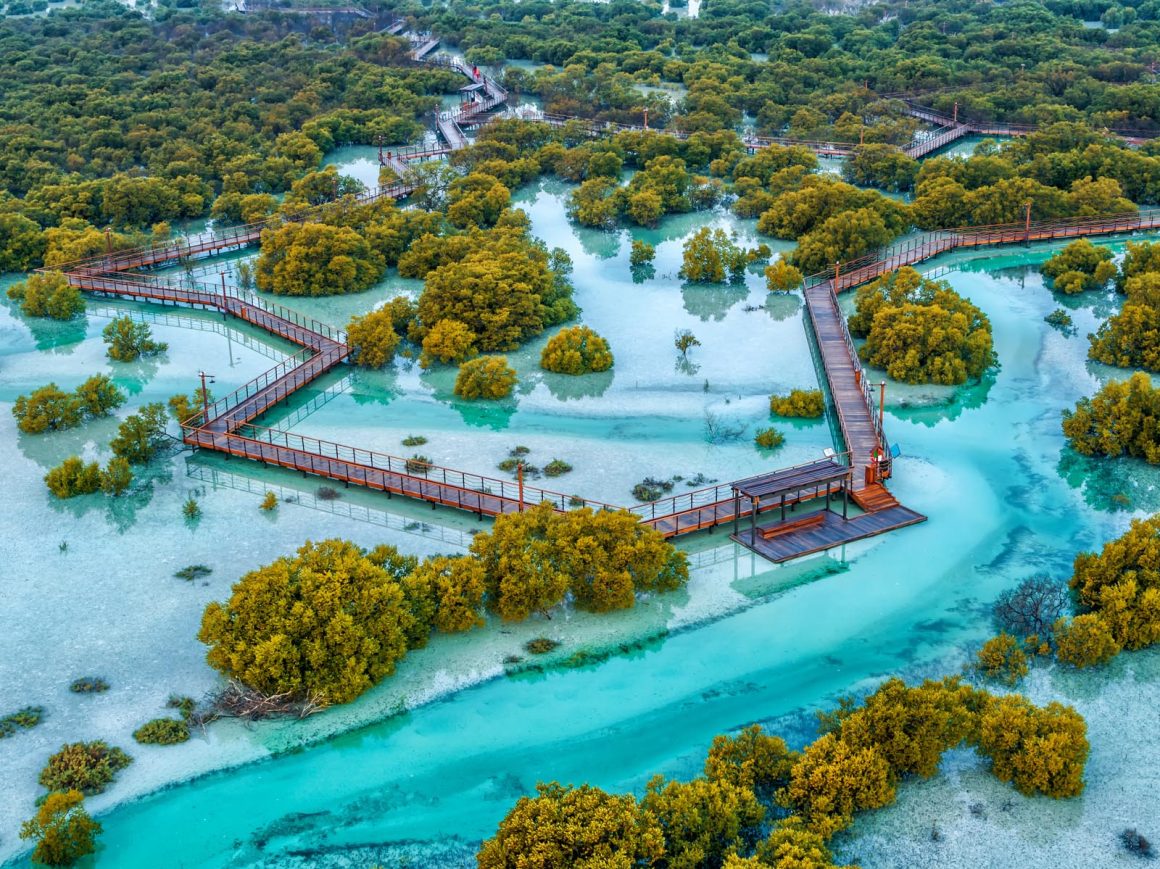The UAE is leading a global initiative to protect and enhance mangrove habitats, which stems from its commitment to addressing climate change and safeguarding vital coastal ecosystems worldwide.
A study by the United Nations (UN) Food and Agriculture Organisation (FAO) found that the area globally covered by mangrove trees declined by 14.8 million hectares between 2000 and 2020 due to factors such as aquaculture expansion, natural retraction, oil palm cultivation, rice farming, and direct human encroachment.
The study highlighted the environmental significance of mangrove trees, which are crucial in protecting coastal communities from natural hazards, such as storms, soil erosion, and tsunamis. Their importance has increased with the growing intensity of extreme weather events and rising sea levels, as they can mitigate the damage caused by waves, severe storms, and soil erosion.
The UAE’s efforts to protect mangroves and restore its prominent role in enhancing global environmental sustainability are vital in the face of this reality. International institutions and organisations that work to address the consequences of climate change have applauded and acknowledged these efforts
The UAE will host a high-level ministerial meeting on mangrove trees during COP28, bringing together mangrove-hosting governments, partners, civil society organisations, foundations, financial institutions, and scientists. The goal is to expand the scope of mangrove trees, accelerate their reintegration into nature, and preserve their unique ecosystems.
During Climate Week NYC, the UAE announced its support for the “Mangrove Breakthrough” initiative, which aims to restore and protect 15 million hectares of mangrove trees globally by 2030. The world only has 14 million hectares of mangroves left, half of their original level.
In November 2022, the UAE launched the global “Mangrove Alliance for Climate,” in partnership with Indonesia, which aims to support, enhance, and expand mangrove forests globally as a nature-based solution to climate change and as part of the international efforts to absorb and reduce greenhouse gas emissions.
The alliance has attracted nearly 20 partners to expand its scope and accelerate the conservation and restoration of mangrove ecosystems to benefit communities worldwide.
The Mangrove Alliance for Climate is a group of entities that share a common vision: to use nature to solve climate change by protecting and planting mangrove trees. Mangroves are valuable ecosystems that can store carbon, reduce coastal erosion, and provide habitat for wildlife.
The alliance’s members aim to highlight their joint commitment to nature-based climate solutions by conserving and restoring mangrove forests; promoting the role of mangroves in climate mitigation and adaptation through innovation and scientific research; ensuring the international protection of mangrove ecosystems by conducting scientific and social and economic studies; encouraging charitable initiatives in society and the private sector to support blue carbon solutions and mangrove tree planting efforts; and strengthening the global efforts to realise the international climate action agenda.
The UAE aims to enhance its nature-based solutions to environmental challenges by increasing its mangrove forest area and has raised its goal of planting a certain number of mangrove trees from 30 million, as stated in the second national contributions report under the Paris Agreement, to 100 million trees by 2030.
Mangrove forests play a key role in protecting the UAE’s coastlines from rising sea levels and severe storms, providing habitats for biodiversity, and acting as natural carbon sinks. The UAE is home to 60 million mangrove trees, covering an area of 183 square kilometres and capturing 43,000 tonnes of carbon dioxide annually. With the addition of 100 million mangrove trees, the total forest area will reach 483 square kilometres, capturing nearly 115,000 tonnes of carbon dioxide annually.
In February 2022, the UAE announced the Abu Dhabi Mangrove Initiative, an ambitious plan to establish the emirate as a global hub for mangrove conservation research and innovation. The initiative focuses on the role of mangrove trees in carbon sequestration and climate change mitigation.
The Environment Agency – Abu Dhabi (EAD) is implementing the initiative with local, regional and international partners. During the first phase of the mangrove tree planting project, the EAD successfully planted one million mangrove tree seeds using innovative drones, a pioneering achievement in the region.
As part of the UAE’s Year of Sustainability in 2023 and the 51st National Day celebrations that took place on 2nd December, 2022, the 51st National Day Organising Committee launched the “Today for Tomorrow: National Day Mangrove Project,” which aims to support the UAE’s pledge to plant 100 million mangrove trees by 2030.
The UAE has a deep cultural and historical connection to mangroves. The country’s passion for these forests goes back to the 1970s when the late Sheikh Zayed bin Sultan Al Nahyan launched the first projects to restore and enhance mangroves.
Some of the UAE’s most significant natural habitats for mangrove trees are the reserves of Ras Al Khor Wildlife Sanctuary in Dubai, the Mangrove and Alhafeya Protected Area in Sharjah, Al Zorah Nature Reserve in Ajman, and Eastern Mangrove National Park, Marawah Biosphere Reserve and Abu Al Sayayif Marine Protected Area in Abu Dhabi
Abu Dhabi has a wealth of mangrove forests along its coast, covering some 70 square kilometres of the emirate’s land. The Mangrove National Park in Abu Dhabi is one of the most densely populated mangrove areas, with more than 19 square kilometres of forests.
By WAM

